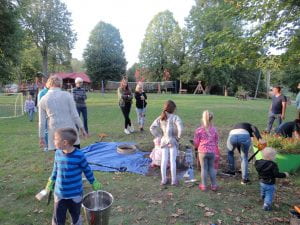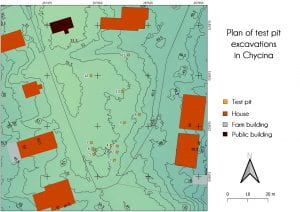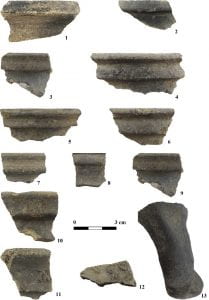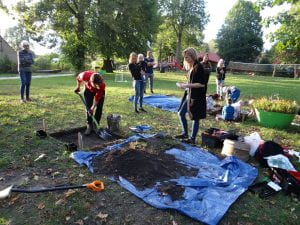 Test pit excavations in Chycina in western Poland in 2019 focused on a central square within the village which is now a playing ground and volleyball pitch for local children. This was because this was the only location whose owner was prepared to give permission for archaeological test pit excavations.
Test pit excavations in Chycina in western Poland in 2019 focused on a central square within the village which is now a playing ground and volleyball pitch for local children. This was because this was the only location whose owner was prepared to give permission for archaeological test pit excavations.
A total of 12 test pits were excavated in Chycina in 2019 over two weekends in September. Altogether, 552 artefacts were unearthed (Krzepkowski 2020).
Test pits 1-4 lay on the south-east of the excavated area. In test pit 1, seven contexts were excavated before reaching natural, yielding finds included pottery, glass and animal bone. A single sherd of late Bronze Age pottery was found in pit 1. The rest of excavated material dates to the thirteenth to eighteenth centuries, plus some modern pottery. Test pit 2 revealed a cobbled floor surface of suspected medieval or early post-medieval date, and test pits 3 and 4 both encountered tree roots which prevented excavation below 20cm.
 Test pits 5-7, slightly west of test pits 1-4, revealed the largest assemblages of thirteenth-to-eighteenth century pottery: 62 thirteenth-to-sixteenth century sherds and 166 dating to the sixteenth to eighteenth centuries, as well as stove tile fragments but only a couple of fragments of animal bone. The presence of 24 and 32 sherds of thirteenth-to-sixteenth century pottery in test pit 5 and 7 respectively strongly suggested habitation in this location at this time. Test pit 6 yielded no late medieval pottery but contained 99 sherds dating to 1600-1800 AD, indicative of a refuse pit, as well as another Late Bronze Age sherd. Test pit 10 was, again, dominated by early modern (sixteenth to eighteenth century) material complemented by a considerable number of late medieval (thirteenth to sixteenth century) sherds and yielded yet another Late Bronze Age sherd.
Test pits 5-7, slightly west of test pits 1-4, revealed the largest assemblages of thirteenth-to-eighteenth century pottery: 62 thirteenth-to-sixteenth century sherds and 166 dating to the sixteenth to eighteenth centuries, as well as stove tile fragments but only a couple of fragments of animal bone. The presence of 24 and 32 sherds of thirteenth-to-sixteenth century pottery in test pit 5 and 7 respectively strongly suggested habitation in this location at this time. Test pit 6 yielded no late medieval pottery but contained 99 sherds dating to 1600-1800 AD, indicative of a refuse pit, as well as another Late Bronze Age sherd. Test pit 10 was, again, dominated by early modern (sixteenth to eighteenth century) material complemented by a considerable number of late medieval (thirteenth to sixteenth century) sherds and yielded yet another Late Bronze Age sherd.
Test pits 8 and 11 were the most easterly of the test pits excavated in Chycina in 2019 and lay on slightly lower ground. Although excavated to 60 and 40cm respectively, they only produced three sherds of pottery pre-dating the eighteenth century, suggesting quite different use of this area in the pre-modern and medieval periods.
Test pits 9 and 12 were notable as the only ones in which the pottery assemblage was dominated by late medieval ceramics rather than post-medieval. Test pit 12 notably produced 50 post-Medieval sherds from the top two contexts, strongly indicating a deliberate deposition, most likely in the form of refuse. Although its presence in two uppermost levels may be due to re-deposition, the sheer number of sherds is indicative of settlement in the area.
 The test pit excavations in Chycina in 2019 were all sited close together in the central square, with test pits 1-7 located within an area c. 20 m2: it is not impossible that they were all sited in a single farm plot. Given that eighteenth/nineteenth century maps show that this excavated area (Fig. 3) had no buildings, the discovery of substantial amounts of pre-1800 AD pottery and domestic structures (including a cobblestone floor) indicates that the square was more intensively used during the past centuries than has previously been suspected. In addition, three late Bronze Age and one early Medieval sherds provide new evidence for even earlier activity in today’s village.
The test pit excavations in Chycina in 2019 were all sited close together in the central square, with test pits 1-7 located within an area c. 20 m2: it is not impossible that they were all sited in a single farm plot. Given that eighteenth/nineteenth century maps show that this excavated area (Fig. 3) had no buildings, the discovery of substantial amounts of pre-1800 AD pottery and domestic structures (including a cobblestone floor) indicates that the square was more intensively used during the past centuries than has previously been suspected. In addition, three late Bronze Age and one early Medieval sherds provide new evidence for even earlier activity in today’s village.
